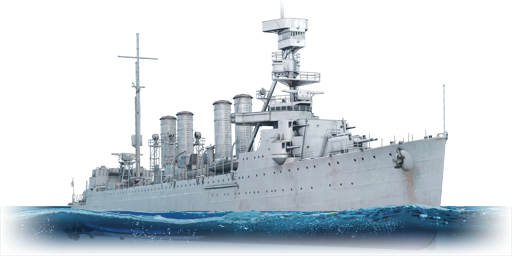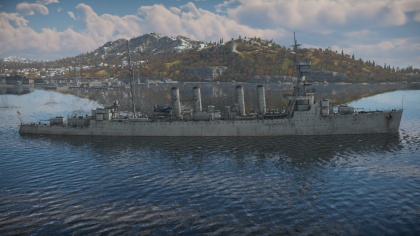USS Trenton
Contents
Description
The Omaha-class, USS Trenton (CL-11), 1930 is a Rank American light cruiser
with a battle rating of (AB), (RB), and (SB). It was first introduced in Update 1.79 "Project X" during the naval closed beta test.
General info
Survivability and armour
The considerable bulk of the Omaha combined with the poor ammunition protection leaves much to be desired. While other first unlock cruisers boast a relatively uniform level `of protection across the hull, the Omaha's armor is concentrated around the engines. From a few angles, the fuel storage can absorb AP shots, but as a rule of thumb it's best to assume the Omaha won't take many hits.
Mobility
With a top speed of 39 mph when spaded, the Omaha in part makes up for its lack of protection with comparatively robust mobility. It is still a light cruiser, however. Turning and maneuvering remains an issue.
Armament
Primary armament
Compared to the other 6-inch and 15 cm guns, the Omaha has a good HE round boasting 5.88 kg of explosive filler and a mediocre SAP round. The Omaha lacks base fuse, distant fuse, and variable time fuse HE shells.
Secondary armament
The 3-inch guns can be brought to bear on small craft and planes alike. They are ineffective against larger targets.
Anti-aircraft armament
The AA protection for targets closer than 2 km is woefully inadequate. Many destroyers are better suited for anti-air defense than you.
Torpedo armament
There are two sets of three torpedos on each side of the Trenton. As the Trenton usually has to present a large cross section of the ship to bring its maximum number of guns to bear, there is very little added effort needed to get the torpedoes lined up.
Usage in battles
The Brooklyn performs adequately against DDs and other CLs at 5.0. On larger maps, the top speed can allow the Omaha to cruise ahead of the other light cruisers, although the bulky profile limits your ability to use surprise and concealment. If possible, group yourself with friendly DDs; your bulk and firepower is an effective counter to 4.7 DDs like the Somers, Sumner, Tashkent, and Akizuki, and the friendly DDs can offer a modicum of AA protection.
Modules
| Tier | Seakeeping | Unsinkability | Firepower | |||
|---|---|---|---|---|---|---|
| I | Dry-Docking | Tool Set | 6 inch Mk.27 SC | 76 mm AP Mk.29 | Anti-Air Armament Targeting | |
| II | Rudder Replacement | Fire Protection System | Smokescreen | 76 mm HE-VT | Auxiliary Armament Targeting | |
| III | Propeller Replacement | Ventilation | Shrapnel Protection | Improved Rangefinder | Primary Armament Targeting | |
| IV | Engine Maintenance | New Pumps | Ammo Wetting | Torpedo Mode | ||
Pros and cons
Summarize and briefly evaluate the vehicle in terms of its characteristics and combat effectiveness. Mark its pros and cons in the bulleted list. Try not to use more than 6 points for each of the characteristics. Avoid using categorical definitions such as "bad", "good" and the like - they have a substitution in the form of softer "inadequate", "effective".
Pros:
-Excellent HE rounds
-Rear turret is able to rotate 360 degrees, allowing faster response to engagements on either side
Cons:
-Poor armor layout
-Tall profile makes for an easier target at range
-AA complement is mediocre
History
In the early 1900s leading up to The Great War, conflicting views and opinions on cruiser design among the U.S. Navy’s top brass led to not a single new vessel of this class being laid down. With the outbreak of hostilities in Europe in 1914 and the later involvement of American forces in the conflict, the U.S. Navy had every opportunity to gather the needed experience for creating a new cruiser design.
Thus, during WW1, numerous design propositions for new cruiser variants and subclasses were developed and assessed. In the end, two designs stood out from the rest; a light cruiser with a displacement of up to 8,000 tons and a heavier battlecruiser weighing up to 46,000 tons. The former of the two designs resulted in the creation of the Omaha-class light cruisers. Despite receiving the Congress’ approval in 1916, the Omaha-class cruisers weren’t put into production before more than two years worth of significant redesigning was done to the ship.
The lead ship of the class, USS Omaha, was laid down in December 1918 followed by 9 further ships of the class seeing completion by 1924. Among her sister ships was also USS Trenton (CL-11), the 8th ship of the class, launched in spring 1923. Trenton, like many American warships of the time, travelled a lot around the globe prior to the outbreak of WW2. She frequently took part in fleet exercises, patrols and maneuvers in the Atlantic and Pacific, whilst also paying visits to several Mediterranean ports. During the Spanish Civil War, Trenton was also involved in evacuating American citizens from the country as part of a smaller squadron.
During WW2, Trenton and her sister ships were already starting to show their age despite being upgraded several times. Therefore, ships of this class were primarily relegated to theaters where enemy opposition was estimated to be minimal and were assigned with less vital missions such as patrol duties and occasional shoreline bombardements. As such, no Omaha-class cruiser was ever lost in combat, though some were severely damaged, such as USS Raleigh during the Pearl Harbor raid. In the end, all ships of the Omaha-class were decommissioned after the end of WW2 and were subsequently sold for scrap by the late 1940s.
- From Devblog
Media
An excellent addition to the article will be video guides, as well as screenshots from the game and photos.
See also
Links to the articles on the War Thunder Wiki that you think will be useful for the reader, for example:
- reference to the series of the ship;
- links to approximate analogues of other nations and research trees.
External links
| USA light cruisers | |
|---|---|
| Omaha-class | USS Detroit · USS Raleigh · USS Trenton |
| Atlanta-class | USS Atlanta |
| Brooklyn-class | USS Brooklyn · USS Helena |
| Cleveland-class | USS Cleveland |
| Fargo-class | USS Fargo |
| Worcester-class | USS Roanoke |





